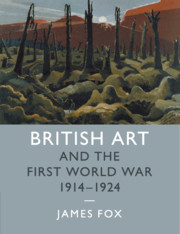Book contents
- Frontmatter
- Contents
- List of plates
- List of figures
- Acknowledgements
- Introduction
- 1 The outbreak of war and the business of art
- 2 Perceptions of art
- 3 The arts mobilize
- 4 War pictures: truth, fiction, function
- 5 Peace pictures: escapism, consolation, catharsis
- 6 Art and society after the war
- Conclusion
- Notes
- Bibliography
- Index
- Index
4 - War pictures: truth, fiction, function
Published online by Cambridge University Press: 05 August 2015
- Frontmatter
- Contents
- List of plates
- List of figures
- Acknowledgements
- Introduction
- 1 The outbreak of war and the business of art
- 2 Perceptions of art
- 3 The arts mobilize
- 4 War pictures: truth, fiction, function
- 5 Peace pictures: escapism, consolation, catharsis
- 6 Art and society after the war
- Conclusion
- Notes
- Bibliography
- Index
- Index
Summary
The early chapters of this book have shown how the outbreak of war damaged the public's appetite and respect for traditional forms of art. The conflict, however, had complex and contradictory cultural consequences. It created both obstacles and opportunities in equal measure. And so while the war caused certain forms of culture to be rejected, it caused others to be embraced with unprecedented enthusiasm. In the first half of the conflict this was emphatically the case for any art form that tapped into what I have earlier referred to as ‘war fever’. Chapter 2 described how the outbreak of hostilities in 1914 triggered an intense public curiosity in the war itself. That curiosity inflected every sphere and register of cultural life: it caused newspaper circulations to increase exponentially and war-themed books to be published and purchased in their thousands; it inspired countless civilians to start writing and reading war poetry; and it led to a surge of plays, concerts and other theatrical performances that all hoped to satisfy the public's craving for topical entertainment.
War fever's most voracious demands, however, were arguably made of visual culture. The public may well have been obsessed with discussing the war, reading about the war and hearing about the war, but above all they wanted to see the war. To civilians the conflict seemed modern, exciting and almost entirely mystifying, and again and again they turned to images to satisfy their curiosity. It would be incorrect to suggest that an aesthetic motivation lay behind these urges. We have already seen that purely aesthetic concerns evaporated as a result of that very same war fever. Moreover, the demands in question were largely indiscriminate: all forms of visual culture, particularly photography and cinema, were implicated in them. Yet they nonetheless had significant artistic consequences. Popular illustrators, Royal Academicians, serving amateurs and official war artists were among the many who produced ‘war pictures’, and most of them found a large and receptive audience for their wares. This chapter will show how that development revived the popularity of pictorial imagery in Britain and in the process helped transform the social status of art.
Seeing the war
The nineteenth and twentieth centuries are often considered to have been predominantly visual centuries. Indeed, the intellectual historian Martin Jay has called vision ‘the master sense’ of the entire modern era.
- Type
- Chapter
- Information
- British Art and the First World War, 1914–1924 , pp. 82 - 108Publisher: Cambridge University PressPrint publication year: 2015



